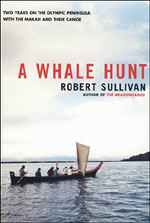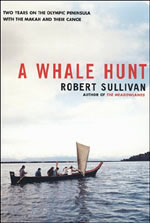For countless generations the Makah Indians have lived on the shores of Neah Bay, in the corner of Washington’s Olympic Peninsula, the northwesternmost tip of the 48 states. Until the 1920s, hunting the gray whales that swam past this stretch of coastline as they migrated between Baja California and Alaska’s Bering Sea had been a Makah tradition for 2,000 years.

Gray whale blues.
Photo: NOAA.
In the early 20th century, commercial whaling pushed gray whales to the brink of extinction and eventually won them the protection of the Endangered Species Act — putting them off-limits to the Makah. But by 1994, the gray whale population had rebounded to such an extent that the species was removed from the endangered species list. When the Makah commenced preparations to revive their traditional hunt in 1997, they had not taken a whale in over 70 years.
Intrigued by the story and its remote geography, journalist Robert Sullivan set off from his home in Portland, Ore., one drizzly fall morning “to see how the Makah would go about hunting a whale.” What began as a short trip to write a magazine article grew into a two-year, book-length undertaking during which Sullivan camped for weeks in one of the continent’s wettest spots, followed the gray whale migration to Mexico, and spent innumerable hours with the Makah whaling crew as they worked to relearn an ancient practice.

A Whale Hunt:
Two Years on the Olympic
Peninsula with the Makah
and Their Canoe
By Robert Sullivan
Scribner, 352 pages, 2000
A Whale Hunt is an engagingly anecdotal book. With conversational ease, Sullivan explains the place of Makah whaling, gray whales, and Neah Bay in the Pacific Northwest’s natural and cultural history, as well as the origins of the anti-whaling movement. He thoroughly captures the atmosphere of that isolated corner of the country where snow-covered mountains slope into the ocean and where the native people and ecosystem have suffered from the exploitation of nature’s bounty. As he did in his quirkily charming and observant Meadowlands, about that oft-disparaged New Jersey region, Sullivan tells this story with wry and subtle humor.
Although sanctioned by the International Whaling Commission, the Makah’s proposed hunt triggered an uproar among animal rights and anti-whaling activists, who considered it akin to commercial slaughter of a vanishing species. The Makah’s wish to restore a tribal rite — the pursuit of an imperiled charismatic megafauna — stirred a controversy that attracted a voracious flock of news media. Sullivan recounts the scene with a sharp eye for ironic and revealing detail.
“A collision of events was about to occur, a coincidence of phenomena: underwater instinctual mammalian migration and a man-based need to define itself. … And … although the Makah were being watched by the television-viewing public (either now or later on the evening news, the local and the national version), … [t]he Makah whale hunters were still out on the water with only their canoe and a whale,” Sullivan writes of the crucial moment of the hunt.
That Sullivan went to Neah Bay with honest curiosity rather than a preconceived opinion about the hunt, with the mission of telling a story rather than saving a whale or a culture — or scooping Headline News — apparently earned him the acceptance of key members of the Makah community. With its personal perspective, A Whale Hunt deftly, and with deceptive ease, sheds light on this tricky intersection of culture and ecology.


